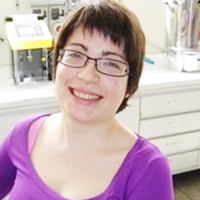The importance of gestational age in first trimester, maternal urine MALDI-Tof MS screening tests for Down Syndrome
Published on: 31st December, 2019
OCLC Number/Unique Identifier: 8513004205
Background: The proposal that MALDI-ToF mass spectrometry could be used as a direct, rapid and affordable diagnostic tool in clinical laboratory medicine has moved from a theoretical possibility to a reality for Microbiology. Several studies have proposed the application of this technology in obstetric and gynaecological evaluation of patients. In particular, we have proposed that the adoption of MALDI-ToF mass spectrometry in examination of maternal pregnancy urine samples for the detection of Downs syndrome.
Methods: A retrospective collection of 20 Down Syndrome and 100 non-aneuploid pregnancy urines at 12 to 14 weeks gestation, collected in 2007-2008 from high risk pregnancy cohorts, were examined by MALDI-ToF mass spectrometry in the mass/charge range between 1000 and 100000 m/z. Normalisation of spectral data was defined using mass bins of 100 m/z expressed as a percentage of the total ion count of the mass spectra from 2000 to 11000 m/z. Of the ninety 100 m/z bins, forty-six were identified as m/z bins at which statistically significant differences in spectra occurred between Downs and control/non-aneuploid samples. Based on the differences and variance, for values at these bins, weighted scores of the probability of being Downs were assigned. Comparative algorithms consisting of various mass bins were tested for ability to distinguish Down syndrome from non-aneuploid pregnancy.
Results: Although various algorithms could distinguish Downs from non-aneuploid controls, it was found that gestational age was a confounding factor and that if separated into gestational age matched cohorts the ability to distinguish the groups improved dramatically e.g. whilst a 19 bins algorithm separated 100% of Downs from non-aneuploid pregnancies for a 9% false positive rate in the mixed gestational ages group; a two bin algorithm distinguished 100% of Downs for a 6% false positive rate for the 12 weeks gestational age pregnancies.
Conclusion: Normalised MALDI-ToF mass spectra, at 2000 to 11000 m/z, of maternal urine gives rise to gestational age specific screening tests algorithms for Downs’s syndrome.
Frequency of renal tubular acidosis in children with down syndrome
Published on: 2nd October, 2020
OCLC Number/Unique Identifier: 8691889815
Background: Down syndrome (DS) is associated with various congenital diseases and malformations, including those of the kidneys and urinary tract. It has been thought that renal tubular acidosis (RTA) is more frequent in this population. The objective of this study was to assess the frequency of RTA and, secondarily, of other renal and urological disorders in persons with DS.
Method: An observational, ambispective, descriptive and cross-sectional study of patients diagnosed with RTA, or suspected kidney or urological disorders, was carried out from July 2016 to September 2017 at the Down syndrome clinic of the Mexican National Institute of Paediatrics. Urinalysis was performed, along with analyses of venous blood gas, sodium, potassium, chlorine, calcium, phosphorus, albumin and creatinine. Those with any abnormal values were referred to nephrology for diagnostic evaluation.
Results: Of a total of 700 patients seen at the clinic, 47 met the selection criteria. Of these, 32 had no RTA or other renal or urological alterations. The remaining 15 continued to the second phase of the study, where 6 were diagnosed with nephropathy or uropathy (RTA, systemic arterial hypertension, monosymptomatic familial haematuria, mild renal failure secondary to reflux nephropathy, urinary tract infection or right ureteropelvic stenosis). Four had mild metabolic acidosis without meeting the criteria for diagnosis of RTA.
Conclusion: RTA is not more common in children with Down syndrome. Nephropathies and uropathies should be investigated in the evaluation of DS patients.
Needs in siblings of individuals with Down Syndrome and levels of coping Cali, Colombia
Published on: 1st November, 2021
OCLC Number/Unique Identifier: 9323541686
Objective: To determine the needs and level of coping in siblings of people with Down Syndrome. Methods: Descriptive, cross-sectional study, carried out in 2016. Sample consisted of 30 siblings of people with Down Syndrome between 6 and 60 years old. Using non-probability convenience sampling. Two instruments were used to collect the information: a) a validated sociodemographic and needs survey of the siblings, designed by the authors, and b). Callista Roy adaptation and coping survey validated. Results: 60% of the siblings report not having felt judged by other people when presenting their brother/sister with Down syndrome. 73.3% of the siblings did not receive information about Down Syndrome from a nursing professional, the need to strengthen the nursing care provided to the siblings of people with disabilities in this regard is evident. 53.3% of these present a medium level of coping with respect to the condition of having a brother with Down syndrome. Conclusion: Identified needs were: time needs, affective needs, family needs, social needs, economic and access to information needs. Highlighting these needs allows the nursing professional to identify and consider the siblings of people with Down Syndrome have different needs than the rest of the family nucleus. Where interventions aimed at reducing the harmful effects and enhancing those characteristics of gain related with having a brother with Down Syndrome.
Prevalence and pattern of congenital heart disease among children with Down syndrome seen in a Federal Medical Centre in the Niger Delta Region, Nigeria
Published on: 11th April, 2022
Background: Down syndrome (DS), or Trisomy 21, is the most common genetic disorder in the world and congenital heart disease (CHD) contributes significantly to morbidity and mortality in this population. Early diagnosis and prompt cardiac intervention improve their quality of life. This study was done to determine the prevalence and pattern of congenital heart disease among children with Down syndrome seen at the Paediatric Cardiology Unit of Federal Medical Centre (FMC), Bayelsa State.Method: A prospective study of children with Down syndrome referred for cardiac evaluation and echocardiography at the Paediatric Cardiology Unit of FMC, Bayelsa State over four years from 1st January 2016 to 30th December 2019. Data on socio-demographic information, echocardiographic diagnosis, and outcome were retrieved from the study proforma and analyzed.Results: A total of 24 children with Down syndrome were seen over the study period. Their age ranged from 0 to 16years. The majority, 20 (83.3%) of the children with Down syndrome were aged 5 years and below. There were 13 males and 11 females with a male to female ratio of 1.2:1. A total of 23 (95.8%) of the children with Down syndrome had CHD. The most common CHD was AVSD (including complete, partial, isolated, or in association with other defects) in 66.6% followed by TOF in 8.3%. Multiple CHDs were seen in 43.5% of the children. Only one child (4.2%) had a structurally normal heart on echocardiography. All the children with Down syndrome had pericardial effusion of varying severity while 33% had pulmonary artery hypertension (PAH). The fatality rate among the children seen with Down syndrome over the study period was 34.8% and only one child (4.2%) had open-heart surgery with the total repair of cardiac defect during the study period. Conclusion: Morbidity and mortality are high among children with Down syndrome due to the high prevalence of CHD. Early referral, diagnosis, and prompt intervention are encouraged.
Amniotic Fluid Ischemia Modified Albumin as a Novel Prenatal Diagnostic Marker for Down Syndrome: A Prospective Case-Control Study
Published on: 21st June, 2023
Aims: There is no study in the literature about ischemia-modified albumin (IMA) and hepatocyte growth factor (HGF) levels in amniotic fluid for Down syndrome cases. The aim of this study was to investigate the changes of IMA and HGF in Down syndrome cases at 16-20 weeks of gestation compared to normal fetuses.Methods: For this prospective case-control study, following reaching the number of 20 women (study group) who had the prenatal diagnosis of Down syndrome, maternal and gestational age-matched pregnant women with normal constitutional karyotype were selected for the control group (n = 74) from the stored amniotic fluid samples. Results: Mean women and gestational ages were comparable between the two groups. Amniotic fluid IMA (1.32 ± 0.13 vs. 1.11 ± 0.11 ABSU, respectively, p < 0.001) and HGF (2743.53 ± 1389.28 vs. 2160.12 ± 654.63 pg/mL, respectively, p = 0.008). Levels were significantly higher in pregnant women having Down syndrome fetuses compared with women having normal fetuses. The amniotic fluid IMA levels for the diagnosis of Down syndrome, and the sensitivity and specificity were calculated as 95.0% and 71.6% for the limit value 1.171 cm3, respectively. Conclusion: In cases with suspected Down syndrome, the diagnosis of Down Syndrome may be made in approximately 1 hour with high sensitivity and specificity by measuring the IMA level in the amniotic fluid sample taken for fetal karyotyping.
Challenges and Concerns of Parents with Children with Down Syndrome
Published on: 18th July, 2023
Down syndrome is a common chromosomal abnormality that affects individuals in their physical, cognitive, and social development. The diagnosis of this syndrome in a newborn can be challenging for parents as it may disrupt family dynamics. In this study, we describe the different aspects of the impact of Down syndrome on parents, including psychological, social, and familial impacts. 55 cases participated in this survey; the average age of parents was 34 years old, and mothers represented 96% of the participants. 70% of cases were from urban areas. The average time between diagnosis and parental evaluation was 32.7 months. In 57% of families, the diagnosis of Down syndrome was established only after the third month of pregnancy, and only 5% obtained it during the prenatal period. Depression was reported in 32% of mothers at the time of diagnosis, while one mother exhibited persistent denial of her child’s disability. 30% of families indicated that their child with Down syndrome was the source of tension within the couple and that learning difficulties were the main factor of tension, while 1% eventually divorced. 5% of parents regretted having a child with Down syndrome. All mothers expressed concerns about their child’s future and are in favor of the establishment of a national screening program for trisomy 21 and dedicated learning centers to ensure social and professional integration.
















